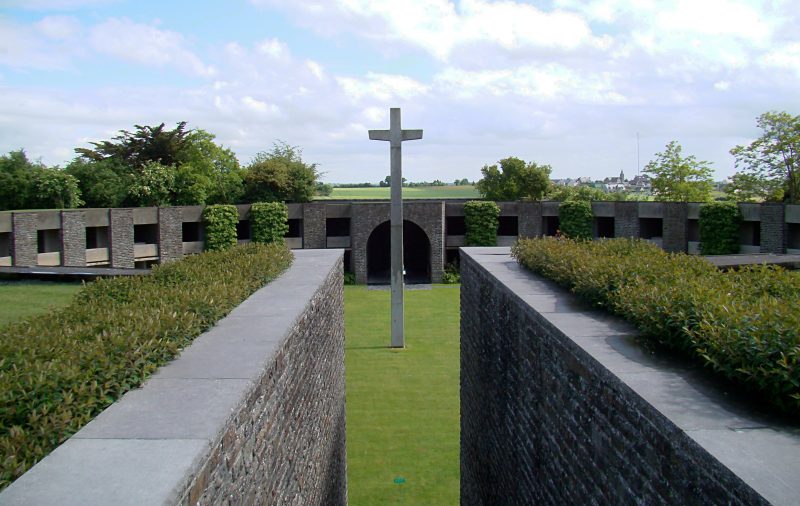Pfc. Lawrence S. Gordon was killed during World War II. His remains were mistakenly turned over by the U.S. military to the Germans and buried in a German cemetery in Huisnes-Sur-Mer, France.
Thanks to Jed Henry, a Wisconsin filmmaker who figured out what had happened to the missing soldier, Gordon’s remains were flown last Wednesday on a commercial American Airlines flight to Chicago. They were escorted by an officer from the U.S. European Command and a special military escort from Washington, DC, in addition to Gordon’s nephew, Lawrence R. Gordon, and Henry.
The Illinois National Guard provided the honors plane-side. They delivered the flag-draped casket to a hearse. The hearse was escorted by Illinois Patriot Guard Riders and Illinois State Police to the Wisconsin Welcome Center near Beloit. There, Wisconsin Patriot Guard members and the Wisconsin State Patrol took over the escort to the University of Wisconsin Hospital.
The driveway to the morgue was lined with American flags, and the casket was carried into the morgue by a military honor guard.
“There were two things I really wanted to do,” said the soldier’s nephew. “Get him — and he’s here now — and have the rosette placed by his name on the wall of the missing” at an American cemetery in France. That was done during a ceremony earlier this week, indicating that the soldier’s remains were no longer missing.
The remains were examined by Leslie Eisenberg, a forensic anthropologist, and Donald O. Simley, II, a forensic odontologist. The two hope to explain the injuries Gordon received before he died.
Gordon’s remains will be sent to a funeral home in Viroqua before being sent to Canada for their final burial on August 13th, the 70th anniversary of Gordon’s death. Gordon served in the US Army, but he was born and raised in Canada.
Gordon’s nephew is happy that the remains were sent to the Germans. He believes that they would not have been able to convince the US military to perform the DNA test on the remains.
Gordon’s nephew had promised his father that he would visit his uncle’s grave in France someday. The family had always assumed that Gordon was buried at Brittany American Cemetery in St. James, France. The military never confirmed that to be true.
In 2000, Gordon’s nephew traveled to France, where he learned that his uncle’s name was on the wall of the missing. The family was never informed that he was missing. They had been told that he was killed in action.
The rosette indicating that he is no longer missing was placed by Gordon’s name on Monday.
On Tuesday, the German War Graves Commission transferred stewardship of Gordon’s remains to his family. The remains were placed in a casket with a US Army dress uniform that had Gordon’s medals and military ribbons on it. An American flag was draped over the casket.
The Joint POW/MIA Accounting Command had committed to being present at the forensic examination at the UW Hospital. They have since canceled all activities due to a commander’s orders. Henry said that he was disappointed by their lack of support.
Gordon is connected to Wisconsin through his grandfather, who was from Viroqua. The two served in the same company during the war. Henry found that Gordon was the only member of their company whose body was never recovered. He began researching military records to find where Gordon was buried.
Henry and a team of four volunteers pieced together the clues that showed that the U.S. had not identified the body correctly and had given the remains to Germany, which interred them in an above-ground German crypt in Normandy.
The U.S. military will not authorize DNA testing of the remains. The German and French governments both agreed to allow the opening of the crypt to test the remains after they were presented the evidence. A French crime lab and two independent U.S. labs confirmed that the remains were Gordon’s by analyzing bone and tooth samples.
Gordon was a member of the US Army Reconnaissance Company of the 32nd Armored Regiment, 3rd Armor Division. He was killed in action on August 13th, 1944, while commanding a tank on a mission to close the Falaise Gap and stop the German 7th Army from escaping to the east.
Gordon was a Canadian who was born to American parents. He had been working on a ranch in Wyoming when he decided to enlist in the US Army rather than the Canadian Army after the bombing of Pearl Harbor. He believed the Americans were better equipped.
His remains will leave Wisconsin for Canada on August 6th. They will be interred for the final time in his hometown of Eastend, Saskatchewan, Canada, near the graves of his father and two brothers.
